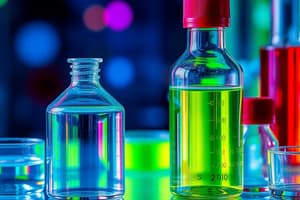Podcast
Questions and Answers
What is the main use of chromatography in pharmaceuticals?
What is the main use of chromatography in pharmaceuticals?
- To produce drugs
- To synthesize new compounds
- To separate and analyze compounds in a mixture (correct)
- To enhance the solubility of drugs
What type of chromatography is specifically used for volatile compounds?
What type of chromatography is specifically used for volatile compounds?
- Ion Chromatography
- Liquid Chromatography
- Gas Chromatography (correct)
- Thin Layer Chromatography
Which of the following represents a limitation of chromatography?
Which of the following represents a limitation of chromatography?
- Requires specialized equipment and training (correct)
- High sensitivity and precision
- Ease of use and no need for training
- Ability to analyze complex mixtures
In liquid chromatography, what is the role of the mobile phase?
In liquid chromatography, what is the role of the mobile phase?
What is a key application of chromatography in pharmaceuticals?
What is a key application of chromatography in pharmaceuticals?
Which chromatography method is most suitable for non-volatile and thermally unstable compounds?
Which chromatography method is most suitable for non-volatile and thermally unstable compounds?
What is method validation in the context of chromatography?
What is method validation in the context of chromatography?
What separates components in chromatography?
What separates components in chromatography?
Flashcards are hidden until you start studying
Study Notes
Pharmaceutical Analysis Chromatography
Overview
- Chromatography: A technique used to separate and analyze compounds in a mixture.
- Essential in pharmaceutical analysis for purity testing, stability studies, and quantifying drug formulations.
Types of Chromatography
-
Gas Chromatography (GC)
- Used for volatile compounds.
- Sample vaporized and carried by an inert gas through a column.
-
Liquid Chromatography (LC)
- Includes High-Performance Liquid Chromatography (HPLC) and Ultra-High-Performance Liquid Chromatography (UHPLC).
- Suitable for non-volatile and thermally unstable compounds.
- HPLC: utilizes high pressure to push solvents through the column.
-
Thin Layer Chromatography (TLC)
- Quick, qualitative analysis.
- Involves a stationary phase on a plate and a mobile phase as a solvent.
-
Ion Chromatography (IC)
- Used for separating ions and polar molecules in solution.
- Effective for analyzing inorganic ions and small organic acids.
Key Principles
- Stationary Phase: The material fixed in place within the column or on a plate.
- Mobile Phase: The solvent or gas that carries the sample through the stationary phase.
- Separation Mechanism: Based on differences in interaction between the components of the mixture and the stationary phase.
Applications in Pharmaceuticals
- Quality Control: Ensuring drug products meet specified standards.
- Stability Testing: Assessing drug degradation over time under various conditions.
- Identification of Impurities: Detecting and quantifying unwanted substances in drug formulations.
- Pharmacokinetics: Studying the absorption, distribution, metabolism, and excretion of drugs.
Considerations
- Method Validation: Ensuring accuracy, precision, specificity, and sensitivity of the chromatography method.
- Regulatory Compliance: Adherence to guidelines set by authorities like FDA and EMA for analytical methods.
- Selection of Conditions: Optimizing mobile phase composition, flow rate, and temperature for best separation results.
Advantages
- High precision and sensitivity.
- Ability to analyze complex mixtures.
- Versatility in different applications and sample types.
Limitations
- Requires specialized equipment and training.
- May have issues with certain sample matrices or components that co-elute.
Conclusion
- Chromatography is a vital tool in pharmaceutical analysis, facilitating the development and quality assurance of drugs through effective separation and identification of compounds.
Overview
- Chromatography separates and analyzes compounds in mixtures, essential for pharmaceutical analysis.
- Important for purity testing, stability studies, and quantifying drug formulations.
Types of Chromatography
- Gas Chromatography (GC): Suitable for volatile compounds; samples are vaporized and transported through a column by an inert gas.
- Liquid Chromatography (LC): Comprises HPLC and UHPLC, used for non-volatile and thermally unstable compounds; HPLC relies on high pressure to move solvents.
- Thin Layer Chromatography (TLC): A quick qualitative method utilizing a stationary phase on a plate and a solvent as the mobile phase.
- Ion Chromatography (IC): Focused on separating ions and polar molecules; effective in analyzing inorganic ions and small organic acids.
Key Principles
- Stationary Phase: Fixed material within the chromatography setup, crucial for separation.
- Mobile Phase: The solvent or gas transporting the sample through the stationary phase.
- Separation Mechanism: Based on varying interactions between sample components and the stationary phase.
Applications in Pharmaceuticals
- Quality Control: Verifies that drug products adhere to established standards.
- Stability Testing: Evaluates drug degradation over time under different conditions.
- Identification of Impurities: Detects and quantifies unwanted substances in formulations.
- Pharmacokinetics: Analyzes how drugs are absorbed, distributed, metabolized, and excreted.
Considerations
- Method Validation: Critical for ensuring the chromatography method's accuracy, precision, specificity, and sensitivity.
- Regulatory Compliance: Must follow guidelines from authorities such as the FDA and EMA regarding analytical methods.
- Selection of Conditions: Optimization of mobile phase composition, flow rate, and temperature is vital for effective separation.
Advantages
- High precision and sensitivity enhance analysis quality.
- Able to analyze complex mixtures efficiently.
- Versatility in applications and types of samples handled.
Limitations
- Requires specialized equipment and extensive training for operation.
- Challenges can arise with specific sample matrices or components that co-elute.
Conclusion
- Chromatography is a crucial technique in pharmaceutical analysis, enabling the development and quality assurance of drugs by effectively separating and identifying compounds.
Studying That Suits You
Use AI to generate personalized quizzes and flashcards to suit your learning preferences.




